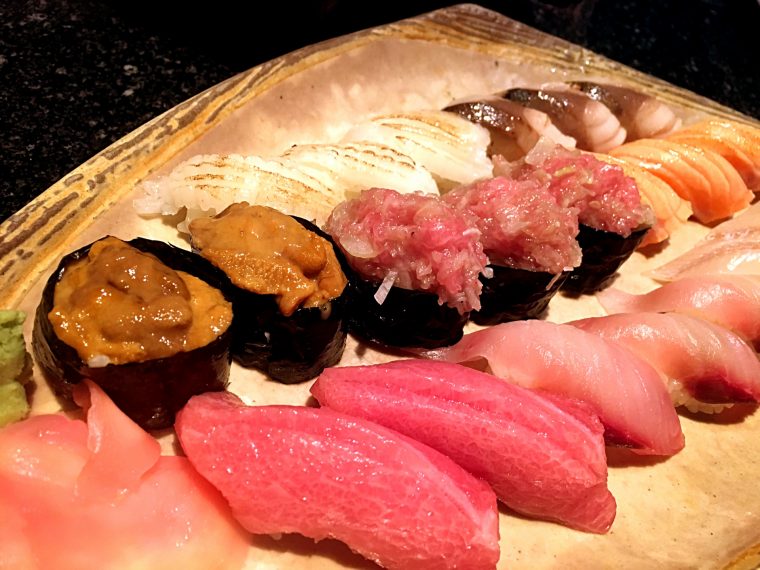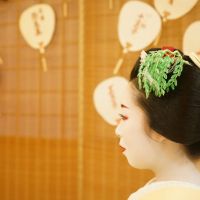Dinner With Geisha in Kyoto
Masaya Osada
Latest posts by Masaya Osada (see all)
Many of Kyoto’s foreign visitors are drawn to the city’s Gion, Pontocho, Miyagawacho and Kamishichiken districts for their traditional tea houses, eateries, and nighttime distractions which offer the chance to snap a picture of a genuine Japanese geisha in all her finery as she hurries past on the street. Yet few tourists, foreign or domestic, will ever have the opportunity to have dinner with a geisha in Kyoto.
When I say few tourists, I do not mean all tourists, for there are opportunities for visitors to experience Kyoto’s geisha tradition directly as honored dinner guests. In this article, I will be comparing three such dinner tours and the entertainments they offer, but first I want to explain a little about the terms geisha.
Contents
- Women in the Geisha Tradition
- Why You Should Experience Dinner with Geisha in Kyoto
- Three Popular Dinner with Geisha Plans
- Which is the Best Dinner show with Geisha for you?
- So, What Does One Talk About with a Geisha?
- Ozashiki Asobi – Playing Games with Geisha during the Dinner Show
- Conclusion
- Even foreigners can now have access to Geisha and Maiko
Women in the Geisha Tradition
Contrary to a still persistent misconception in some parts of the world, geisha are not, nor were they ever, prostitutes. They are in fact artisans – not courtesans – being highly trained practitioners of traditional Japanese arts and customs of hospitality. As accomplished performers, story-tellers, singers, dancers and musicians, their services have long been revered and coveted by the Japanese elite. Although geisha is today a generic term throughout Japan, these women are still known as geiko in Kyoto.
Maiko, on the other hand, are apprentice geiko (who might otherwise be known as hangyoku in Tokyo). Much about the lengthy five-year training they undergo to become geiko remains a closely guarded secret, but their need to practice the arts they are learning means that they are much more accessible for travellers seeking a new and unique experience. Hence the three dinners with maiko choices that I will compare below.
If you want to get more information about the difference between Geisha and Maiko, please visit her
Why You Should Experience Dinner with Geisha in Kyoto
One should never compare dinner with geisha to those fake medieval banquets one finds in many of Europe’s historic cities; the geisha tradition is a living culture and is as relevant today as it was in 19th century Japan. Indeed, you might feel it remiss of yourself should you not take the opportunity to experience this most quintessential aspect of Japanese culture when visiting Kyoto.
Yet it is a fact that geisha are virtually impossible to meet, except through personal recommendation or referral. There are no venues where one can just walk in off the street and be entertained by geisha, and that applies equally to high ranking Japanese as it does to backpackers from abroad – without the necessary introductions, geisha will not accept engagements.
One should never compare dinner with geisha to those fake medieval banquets one finds in many of Europe’s historic cities; the geisha tradition is a living culture and is as relevant today as it was in 19th century Japan. Indeed, you might feel it remiss of yourself should you not take the opportunity to experience this most quintessential aspect of Japanese culture when visiting Kyoto. Yet it is a fact that geisha are virtually impossible to meet, except through personal recommendation or referral. There are no venues where one can just walk in off the street and be entertained by geisha, and that applies equally to high ranking Japanese as it does to backpackers from abroad – without the necessary introductions, geisha will not accept engagements.
For these reasons alone, the dinner with geisha plans outlined below represents a wonderful opportunity to experience something that so few people ever have the chance to try. That they are also immense fun, as well as culturally fascinating, makes them even more memorable, showcasing something of the versatility as hosts and performers that geisha are famed for being.
In addition, these plans all include a full kaiseki dinner featuring a course of various traditional dishes, all exquisitely prepared and presented with the aesthetic flair one can expect of Kyoto’s haute cuisine. A typical kaiseki meal may include the following:
Suimono (Soup)
- Sashimi (hand-prepared raw fish)
- Nimono (Boiled Dish)
- Yakimono (Grilled Dish)
- Agemono (Deep Fried Dish)
- Mushimono (Steamed Dish)
- Sunomono (Vinegared Dish)
- Shokuji set – Rice, Miso Soup, and Tsukemono (pickled vegetables)
Notice too that the main dishes are all prepared according to the fundamental methods of cooking in Japanese cuisine, each with its own unique properties and using seasonal ingredients.
Three Popular Dinner with Geisha Plans
So now I have whetted your appetite, we will take a look at three popular dinners with geisha experiences in Kyoto:
- Enchanted Time with MAIKO – http://www.travel-kyoto-maiko.info
- Kyoto Dining with Maiko – http://www.gionhatanaka.jp/maiko/english/about.html
- Ganko Takasegawa Nijoen, Maiko Plan –
For the purposes of comparison, this table shows the basic details at a glance for each choice, including prices per head:
|
DINNER PLAN |
INCLUDES |
INTERPRETER |
TAKE PHOTOS/VIDEOS |
|
¥19,000 p/head (19yrs +) ¥17,000 p/head (13-18yrs) ¥13,000 p/head (7-12yrs) Under 7s Free Every Tues. & Thurs. 6-8pm Location: Yasaka-Dori Enraku |
Chatting with Geisha Playing games with Geisha Special gift from Geisha Free all-you-can-drink |
English speaker provided |
Okay at any time during the evening Posed photos at the end of the evening Guests receive pictures taken by staff at the end |
|
¥19,000 p/head Mon/Wed/Fri/Sat. 6-8pm Location: Gion Hatanaka |
Geisha dance performance Geisha service Chatting with Geisha Free all-you-can-drink |
English speaker available |
Okay at any time during the evening |
|
Ganko Maiko Plan ¥5,000 p/head + ¥45,000 for 1 maiko Times specified by guests Location: Ganko Takasegawa Nijoen |
After dining Geisha dance Chatting with Geisha |
Not specified |
After dining, time permitting |
Based on the information available at the time of writing, it is clear that these are three quite different geisha experiences in some ways. But as program details may change over time, please visit the respective English web pages above for updated information before making any final decisions. However, as far as what the three dinner plans have to offer, I think it is worth considering the venues themselves first of all, as they will each have their own unique ambiance. Both Yasaka-Dori Enraku and Ganko Takasegawa Nijoen are well-known restaurants serving traditional Kyoto cuisine, though the latter is probably better known as a delightfully gardened restaurant with a geisha option, and the former, for hosting the Enchanted Time with Maiko.
Reviews on “TripAdvisor” are favorable for both restaurants, but Yasaka-Dori Enraku’s Enchanted Time with Geisha consistently receives 5-star glowing praise, both for the food and the Geisha entertainment. Gion Hatanaka, on the other hand, is a ryokan – a traditional style Japanese inn of a kind that has existed since at least the 8th century. Much of Japan’s culture of hospitality, including kappo style dining, is rooted in the country’s ryokan, so it is no surprise that they eventually became an important component of the geisha tradition. Being first and foremost a guest house, Gion Hatanaka’s “TripAdvisor” reviews reflect its high standard of service, comfort, and cuisine, but there is little mention of its geisha evenings. On the face of it, Kyoto Dining with Geisha seems rather similar to Enchanted Time with Maiko, certainly in its pricing, but I suspect it is aimed more at their staying guests.
Which is the Best Dinner show with Geisha for you?
As kaiseki dining experiences go, I would imagine there is little to choose between the three Geisha plans; lavish traditional courses are something they do really well in Kyoto, so try not to fill up during the day! But if you have any particular objections to raw fish for example, or special dietary requirements (vegetarian, vegan, Halal, etc.), make them known at the time of booking. Again, check the websites for information.
Ganko Takasegawa Nijoen Geisha Plan would probably suit those for whom the experience of a traditional Japanese restaurant is as important, if not more so than the Geisha experience per se. It is certainly a very sophisticated restaurant with quite picturesque grounds, but the Geisha plan might be a tad expensive for a couple alone, especially if one factor in a good bottle of sake. However, with the kaiseki set discount for a group of 20 people sharing one Geisha, the plan becomes much more economical.
Kyoto Dining with Geisha will certainly appeal to guests at the Gion Hatanaka ryokan, as the frequency of their Geisha evenings throughout the week is a definite plus point for anyone with only a limited time in Kyoto. Visitors who find it difficult to be seated at floor level will also appreciate the exclusive table and chair seating, whilst the food and table service is likely to be of a high order.
Enchanted Time with MAIKO is, however, the most immediately enticing of the three choices I looked at, not least because the website is so clear, concise and informative compared to the other choices. One is left in no doubt about the program, what happens at each stage of the evening, and the availability of price concessions for younger guests, or special dietary considerations, etc. From the website’s many photographs, one gets the impression of a fun event in an intimate space.
So, What Does One Talk About with a Geisha?
One thing to bear in mind is that however many Geisha are in attendance, their conversation time will be divided between several guests, so you should limit your questions to ones that are of most interest to you. Your interpreter, if you do not speak Japanese, will also be extremely busy, so try not to tax them with difficult questions. It will be a good idea to prepare your questions well in advance, and to help you with this, here are some facts relating to geisha and maiko:
- Kimono – maiko tend to wear brightly-colored, long-sleeved kimono with broad sashes (obi) tied behind in a bow. Geisha kimono are different in many ways and are altogether more sober and unassuming. Kimono are generally worn to reflect the current season with patterned motifs very much in evidence. Kimono are extremely expensive, so having one for each season represents a major investment for both maiko and geisha.
- Wooden sandals – many foreigners are already familiar with the traditional ribbed geta and flat-bottomed zori worn by geisha, but maiko usually wear the much higher okobo.
- Hairstyles – geisha wear comparatively simple wigs over their natural hair, but maiko style their own hair into elaborate arrangements that signify the level of training they are at.
- Accessories – geisha wear far fewer and simpler ornaments in their hair than do maiko. One of the most elaborate maiko hair ornamentations is the hana-kanzashi, with silk flowers that hang down to maiko’s chin – it is worn during the first year of training (minarai stage) only. As with kimono, seasonal motifs are common to all hair ornaments.
- Makeup – one unmistakable feature of a Geisha’s face will be the strip of unpainted skin around the hairline that comes from not wearing a wig. Maiko’s eyebrows are far more strongly defined in red than those of geisha, whilst their eyes are lined in both black and red. In the first year of training, only the maiko’s bottom lip is painted bright red, whereafter they adopt the full lip paint of geisha.
Above all, avoid asking the Geisha any personal questions; they are very open and fun-loving young professional women, but they have a right to privacy and respect. Similarly, do not touch a Geisha’s hair, face or attire, though I am sure she would allow you to gently feel the silk sleeve of her kimono if you ask her nicely.
Ozashiki Asobi – Playing Games with Geisha during the Dinner Show
Actually, Ozashiki Asobi is the name given to drinking parties with Geisha, but these days it more often refers to the games played at dinner with Geisha style events. The Japanese love their drinking games, and to make fools of themselves – think of Japanese game shows and karaoke – and Geisha are adept at encouraging their guests to do just that!
Many of these games are variations on the stone, paper, scissors theme, often played to a timing provided by a Geisha playing the shamisen whilst singing. Playing games such as Tora Tora Tora, Tōsenkyo, Kitsune Ken or Konpira Fune Fune can be a real test of hand-eye coordination and concentration.
Konpira Fune Fune, for example, involves two players sitting either side of a small table with a small box or bowl on top. While a Geisha plays the game’s song on the shamisen, the players take turns touching the box to the rhythm.
If the box is there, the player must show paper, but if the box is gone, they should show rock. On any turn, either player can take the box away (still keeping rhythm), so if the other player shows paper when the box is gone, or rock when the box is still there, he or she loses. Confused? Try it after a couple of flasks of
Conclusion
As you can see, a dinner with Geisha plan is a fully immersive package offering a truly unique insight into an enduring aspect Japanese culture and is highly recommended for all visitors to beautiful old Kyoto. In fact, I would argue that the geisha tradition being kept alive in Kyoto today represents a special part of everyone’s worldwide cultural heritage, with Geisha its friendly-faced ambassadors.
Even foreigners can now have access to Geisha and Maiko
We are proud to offer an excellent opportunity for foreign visitors to Kyoto to meet and interact directly with Geisha, at an exceptional price, every Tuesday, Thursday, and Sunday from 6 pm to 8 pm. This tour includes dinner, an English guide, watching a traditional dance performance, and be able to play a unique game with the Geisha.
Are you curious about this tour? Check the detailed information, and make an online reservation now to meet an authentic Japanese Geisha in Kyoto!



